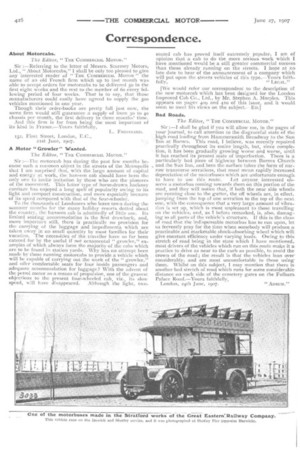Correspondence.
Page 24

If you've noticed an error in this article please click here to report it so we can fix it.
About Motorea.bs.
The Editor, " THE COMMERCIAL MOTOR."
Sir :—Referring to the letter of Messrs. Sturmey Motors, Ltd., "About Motorcabs," I shall be only too pleased to give any interested reader of "THE COMP.IERCIAL MoTotz " the name of an old French firm which up to last month was able to accept orders for motorcabs to be delivered 5o in the first eight weeks and the rest to the number of 6o every following period of four weeks. That is to say, that those manufacturers could easily have agreed to supply the 500 vehicles mentioned in one year.
Though their order-books are pretty full just now, the same firm would still guarantee a supply of from 30 to 40 chassis per month, the first delivery in three months' time.
And this firm is far from being the most important of its kind in France.—Yours faithfully,
L. FuoissARD, 152, Fleet Street, London, RC.,
21St June, 1907.
A -Motor "Growler" Wanted.
The Editor, "THE COAIMERCiAL MOTOR."
Sir :—The motorcab has during the past few months become such a common object in the streets of the Metropolis that I am surprised that, with the large amount of capital and energy at work, the hansom calk should have been the only one to invite imitation by those who are the pioneers of the movement. This latter type of horse-drawn hackney carriaze has enjoyed a long spell of popularity owing to its light and compact construction, and more especially because of its speed compared with that of the four-wheeler.
To the thousands of Londoners who leave town during the summer months for the many holiday resorts dotted about the country, the hansom cab is admittedly of little use. Its limited seating accommodation is the first drawback, and, more importart still, there is practically no provision for the carrying of the luggage and impedimenta which are taken away in no small quantity by most families for their vacation. The necessities of the traveller have so far been catered for by the useful if not ornamental " growler," examples of which always form the majority of the cabs which are to be found in station yards. Why has no attempt been made by those running motorcabs to provide .a vehicle which will be capable of carrying out the work of the " growler," and offer comfortable seats for four inside passengers and adequate accommodation for luggage? With the advent of the petrol motor as a means of propulsion, one of the gravest objections to the present four-wheeled cab, viz., its slow speed, will have disappeared. Although the light, two
seated cab has proved itself extremely popular, I am of opinion that a cab to do the more serious work which I have mentioned would be a still greater commercial success. than those already running on the streets. I hope at no late date to hear of the announcement of a company which will put .upon the streets vehicles of this type.—Yours faith
fully, "'LEGAL."
[We would refer our correspondent to the description of the new motorcab which has been designed for the London Improved Cab Co., Ltd., by Mr. Stephen A. Marples. This appears on pages 409 and 410 of this issue, and. it would. seem to meet his views on the subject.ED.]
Bad Roads,
The Editor, "THE COMMERCIAL MOTOR."'
Sir shall be glad if you will allow me, in the pages of your journal, to call attention to the disgraceful state of the high road leading from Hammersmith Broadway to the Sun Inn at Barnes. This road, I believe, was recently repaired practically throughout its entire length, but, since completion, it has been gradually growing worse and worse, until. it has reached its present state of imperfection. There is a particularly bad piece of highway between Barnes Church: and the Sun Inn, and here the surface takes the form of narrow transverse serrations, that must mean rapidly increased. depreciation of the motorbuses which are unfortunate enough
to have to use this route. I.et anyone interested observe a motorbus coming towards them on this portion of the road, and they will notice that, if both the near side wheels. are running close to the gutter, the off wheels are, in effect, jumping from the top of one serration to the top of the next one, with the consequence that a very large amount of vibration is set up, which is most unpleasant to those travelling on the vehicles, and, as I before remarked, is, also, damaging to all parts of the vehicle's structure. If this is the class of road that the indispensable motorbus has to run upon, let us fervently pray for the time when somebody will produce a. practicable and marketable shock-absorbing wheel which will give constant efficiency under varying loads. Owing to this stretch of road being in the state which I have mentioned,. most drivers of the vehicles which run on this route make it a. practice to drive as near to the curb as possible, to avoid the crown of the road; the result is that the vehicles lean over considerably, and are most uncomfortable to those using them. Whilst on this subject, I may mention that there is another bad stretch of road which runs for some considerable distance on each side of the cemetery gates on the Fulham. Palace Road.—Yours faithfully, London, 24th June, 1907. `` ADSUAL".






























